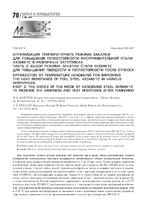Оптимизация температурного режима закалки для повышения теплостойкости инструментальной стали 4Х5МФ1С в различных заготовках. Часть 2. Выбор режима закалки стали 4Х5МФ1С для повышения твердости и теплостойкости после отпуска
Another Title
Optimization of temperature hardening for improving the heat resistance of tool steel 4Х5MФ1С in various workpieces. Part 2. The choice of the mode of hardening steel 4Х5MФ1С to increase the hardness and heat resistance after tempering
Bibliographic entry
Федулов, В. Н. Оптимизация температурного режима закалки для повышения теплостойкости инструментальной стали 4Х5МФ1С в различных заготовках. Часть 2. Выбор режима закалки стали 4Х5МФ1С для повышения твердости и теплостойкости после отпуска = Optimization of temperature hardening for improving the heat resistance of tool steel 4Х5MФ1С in various workpieces. Part 2. The choice of the mode of hardening steel 4Х5MФ1С to increase the hardness and heat resistance after tempering / В. Н. Федулов // Литье и металлургия. - 2017. – № 3 (88). - С. 70-77.
Abstract
Разработан новый режим термической обработки, включающий закалку в масле от температуры 1150 °C с использованием отпуска при температуре 500–650 °С в течение 1,5 ч. Эффект повышения уровня упрочнения и теплостойкости определяется более полным растворением матрицы стали, укрупнением зерен и морфологии первичных фаз структуры в результате высокотемпературного нагрева и увеличения количества вторичных фаз в результате отпуска. Результаты работы могут использоваться при производстве рабочих частей высокоресурсного инструмента для горячего формообразования.
Abstract in another language
A new mode of heat treatment, including oil quenching from temperature 1150 °C with tempering at 500–650 °С for 1,5 hours was developed. The effect of increasing the level of hardening and the heat resistance is determined by more complete dissolution of the steel matrix, the coarsening of grains and morphology of the primary phase of the structure and as a result of high temperature heating and increasing of the number of secondary phases as a result of the tempering. The results of the work could be used in production of working parts is highly resourceful tool for heat forming.
View/
xmlui.dri2xhtml.METS-1.0.item-link-otherpart
Ч. 1, https://rep.bntu.by/handle/data/31589Collections
- №3 (88)[22]

